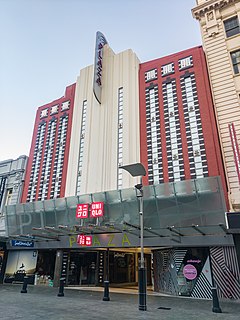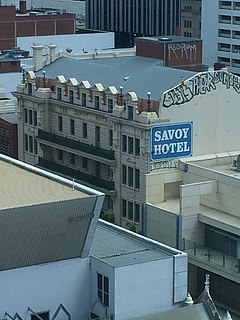
Broome, also known as Rubibi by the Yawuru people, is a coastal, pearling and tourist town in the Kimberley region of Western Australia, 1,681 km (1,045 mi) north of Perth. The estimated urban population was 13,984 in August 2016. It is the largest town in the Kimberley region.
Greater Union Organisation Pty Ltd, trading as Event Cinemas, Greater Union, GU Film House, Moonlight Cinema and Birch Carroll & Coyle, is the largest movie exhibitor in Australia and New Zealand, with over 140 cinema complexes currently operating worldwide.

The Perth Festival, named Perth International Arts Festival (PIAF) between 2000 and 2017, and sometimes referred to as the Festival of Perth, is Australia's longest-running cultural festival, held annually in Western Australia. The program features contemporary and classical music, dance, theatre, opera, visual arts, large-scale public works. The main events of the festival take place every year from February to March, with the Perth Writers Festival occurring in February, while the film festival now known as Lotterywest Films runs from November to April, as part of the Perth Festival.
James Ronald Chi was an Australian composer, musician and playwright. His best known work is the 1990 musical Bran Nue Dae which was adapted for film in 2009.

The Shire of Broome is one of the four local government areas in the Kimberley region of northern Western Australia, covering an area of 55,796 square kilometres (21,543 sq mi), most of which is sparsely populated. The Shire's estimated population as at the 2016 census was 16,222 most of whom reside in the town of Broome. Many Aboriginal communities are within the Shire, notably Beagle Bay and Bardi.

An atmospheric theatre is a type of movie palace design which was popular in the late 1920s. Atmospheric theatres were designed and decorated to evoke the feeling of a particular time and place for patrons, through the use of projectors, architectural elements and ornamentation that evoked a sense of being outdoors. This was intended to make the patron a more active participant in the setting.

Supreme Court Gardens is a park in the central business district of Perth, Western Australia, bounded by Riverside Drive, Barrack Street, Governors Avenue, and the buildings of the Supreme Court of Western Australia.

Cygnet Cinema is located at 16 Preston Street, Como, Western Australia. It was the first purpose built sound cinema in the suburbs immediately south of the city in the inter-war period. The Cygnet Cinema opened in 1938 and was built by local identity and film entrepreneur James Stiles. It is an excellent example of the art deco style of architect William Leighton and is included on the State's Heritage Register.

The Astor Theatre is located at 659 Beaufort Street, Mount Lawley, Western Australia. It comprises a single, two and three-storey masonry Inter-war Art Deco style theatre and retail building.
Thomas James Snooks (1890–1958) was a pioneering picture-show man and a developer-builder in the north-eastern suburbs of Perth, Western Australia. In addition to his professional interest in cabinet-making and building, Tom possessed a love for live theatre, staging a number of Gilbert and Sullivan productions in the Maylands Methodist hall, when he was in his early twenties. Not long after the First World War he began showing silent films at a number of venues in Maylands - at the Maylands town hall and the old Lyric Theatre - as well as in Bassendean, and Inglewood, under the business name Central Pictures. By staggering the starting times, Tom and his brothers were able to shuffle canisters of film between competing venues via a speeding motor cycle, thereby keeping the local police force on its toes. In the early days, Tom would go on stage to introduce the silent films, as he believed in the power of the word as well as the image.
Palace Cinemas is the fifth largest major cinema chain in Australia, with various locations in CBD and inner suburban areas of most capital cities. Palace Cinemas currently comprises 24 cinemas with 180 screens and more than 550 staff. Its head office is based in the Melbourne suburb of South Yarra, close to its Cinema Como flagship.

Bran Nue Dae is a 2009 Australian musical comedy-drama film directed by Rachel Perkins and written by Perkins and Reg Cribb. A feature film adaptation of the 1990 stage musical Bran Nue Dae by Jimmy Chi, the film tells the story of the coming of age of an Aboriginal Australian teenager on a road trip in the late 1960s.

The Piccadilly Cinema Centre and Piccadilly Arcade are located at 700-704 Hay Street, Perth, Western Australia. It is an art deco style cinema and shopping arcade, designed by architect William T. Leighton for mining entrepreneur Claude de Bernales. The theatre and arcade opened in 1938, with the arcade connecting Hay Street through to Murray Street.

The Windsor Cinema is located at 98 Stirling Highway, Nedlands, Western Australia. It is an Art Deco cinema designed by the architect William T. Leighton and constructed in 1937. It is currently leased by Luna Palace Cinemas.

Luna Leederville is a cinema complex located at the corner of Oxford and Vincent Streets in Leederville, a suburb of Perth, Western Australia.

The former Plaza Theatre is located at 650–658 Hay Street, Perth, Western Australia. It was the first purpose-designed Art Deco cinema in Perth. The Plaza Theatre opened in 1937 and was built for Hoyts Theatres Ltd.

The Oriana Cinema was an art deco cinema and theatre built in 1938 in Fremantle, Western Australia and demolished in the early 1970s.

The Savoy Hotel is a heritage-listed former hotel in Hay Street, Perth, Western Australia. It was built in the 1910s and closed in 1991. It is listed on the State Register of Historic Places, has been classified by the National Trust of Australia, and was listed on the former Register of the National Estate.

The Princess Theatre, located at 29–33 Market Street, Fremantle, Australia, was built in 1912. It closed in 1969 and is now used for offices and retail businesses.
The Grand Theatre was a theatre and cinema located at 164–168 Murray Street, Perth, Western Australia. It was opened in September 1916 and closed in November 1980. The building was demolished in March 1990.

















